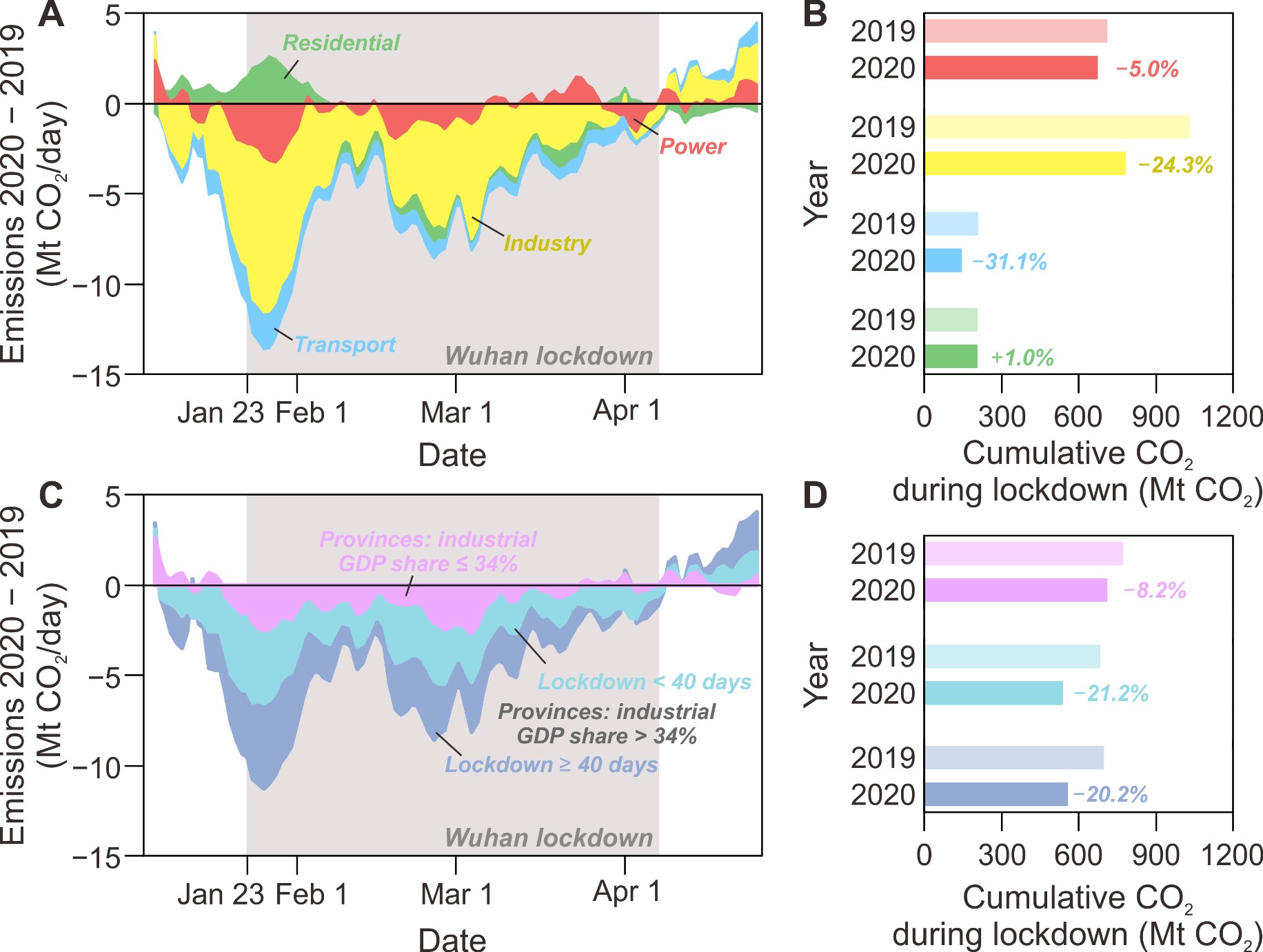On December 2, Professor Zhang Qiang's research group from the Department of Earth System Science (DESS) of Tsinghua University published a paper. This thesis constructed a high-temporal-resolution dynamic inversion technology for carbon emissions that combines satellite remote sensing observations and bottom-up emission source information, and based on this, quantified China’s CO₂ emissions by provinces and sectors from January to April 2020. The daily dynamic changes reveal the impact of COVID-19 pandemic prevention and control measures on industrial activities, and it is concluded that after the unblocking, the rapid rebound of industrial activities has become the main driving force of China's carbon dioxide emissions changes during the pande. The paper is titled Satellite-based estimates of decline and rebound in China’s CO₂ emissions during COVID-19 pandemic and was published online on Science Advances.
CO₂ is the main driver of climate change and the core constraint target of climate energy policy. In the first half of 2020, the COVID-19 pandemic control measures such as city lockdowns, production shutdowns, and traffic control have reduced the intensity of social and economic activities, greatly reducing fossil energy consumption and CO₂ emissions, and economic stimulus policies after the pandemic has eased may boost emissions rebound. Timely and accurately tracking the dynamic changes of CO₂ emissions from human activities is of great significance for enhancing the ability to respond to climate change and improving the flexibility and adaptability of policy actions. Quantitative emission methods based on macro-statistics and near-real-time big data can timely measure the dynamic changes of emissions during the pandemic, but the sectoral and spatial coverage of near-real-time data on a daily scale is incomplete, and the uncertainty introduced by this lack of observation Independent verification of data.
In response to this problem, Professor Zhang Qiang’s research group led the establishment of a high-temporal-spatial resolution CO₂ emission retrieval technology that couples near-real-time nitrogen oxide satellite remote sensing observations, atmospheric chemistry transmission models, and bottom-up emission source information. This is the first time to quantify based on observations. During the COVID-19 pandemic, the dynamic changes of China's CO₂ emissions by provinces and departments on a daily scale. The study found that when the city was closed from the end of January to the beginning of 2020, the country's CO₂ emissions fell by more than 40% compared with the same period in 2019. With the rapid containment of the domestic COVID-19 pandemic in China, since mid-to-late February, low-risk areas have resumed work and production in an orderly manner, and the country's CO₂ emissions have gradually rebounded. Since the nationwide unblocking in early April, CO₂ emissions in April were 2.7% higher than in 2019. In the first four months of 2020, China’s CO₂ emissions fell by 11.5% compared to the same period in 2019.

Figure. The daily change of CO2 emissions by sectors and regions in China during the 2020 COVID-19 pandemic
Studies have shown that the economic production structure of various provinces, the intensity of pandemic prevention and control, and the intensity of economic stimulus measures jointly determine the decline and rebound of man-made CO2 emissions during the COVID-19 pandemic. Emission inversion results based on satellite remote sensing show that, with the exception of Hubei, Beijing-Tianjin-Hebei, and the Yangtze River Delta, which have the most stringent pandemic control measures, provinces dominated by industrial economies have reduced emissions more significantly during the lockdown period. At the same time, emissions rebounded more rapidly in these provinces after the closure of the city. China's industrial-dominated economic structure determines the dynamic response of CO2 emissions to the COVID-19 pandemic, that is, the industrial sector is the main driving force for the decline and rebound of China's CO2 emissions during the pandemic. This study has established a new high-resolution near-real-time inversion technology system for CO2 emissions changes. This method can be applied to the United States, Europe, and India and other regions where human emissions dominate in the future to measure the emission dynamics variety in these regions during the COVID-19 pandemic.
Zheng Bo, a postdoctoral fellow at the French Laboratory of Climate and Environmental Sciences (currently an assistant professor at Tsinghua Shenzhen International Graduate School), and Geng Guannan, an assistant researcher at the School of Environment of Tsinghua University, are the co-first authors of the paper, and Professor Zhang Qiang from DESS of Tsinghua University is the corresponding author. Professor Philippe Ciais of the French Laboratory of Climate and Environmental Sciences, Professor Steven Davis of the University of California Irvine, Professor Guan Dabo from DESS of Tsinghua University, and Professor He Kebin of the School of Environment of Tsinghua University are the co-authors. The research was supported by the Innovative Research Group Project of the National Natural Science Foundation of China and The National Science Fund for Distinguished Young Scholars.
Original link: https://advances.sciencemag.org/content/6/49/eabd4998
Writers: Zhang Qiang’s Research Group
Review: Wu Haiping
Editor: Wang Jiayin